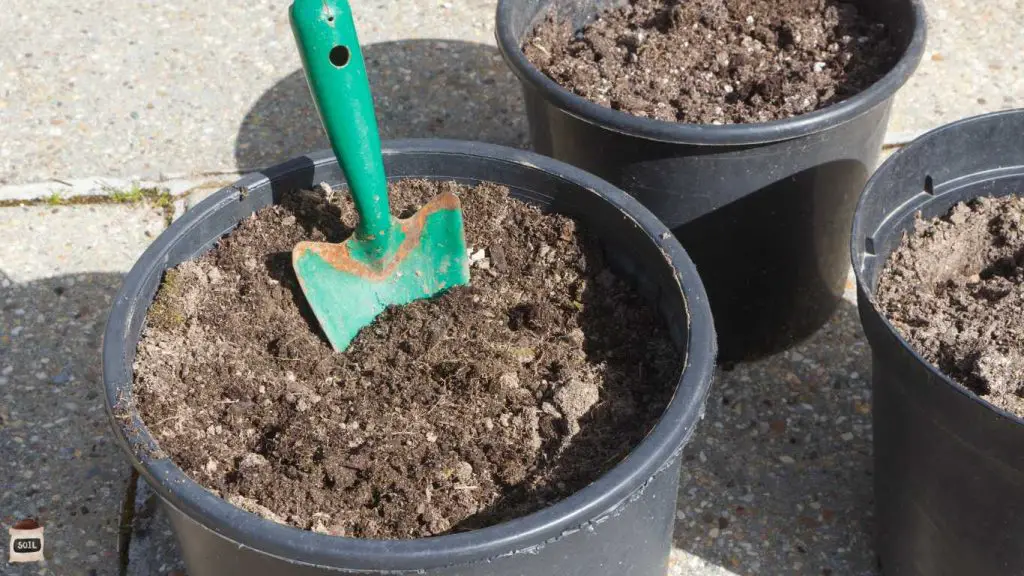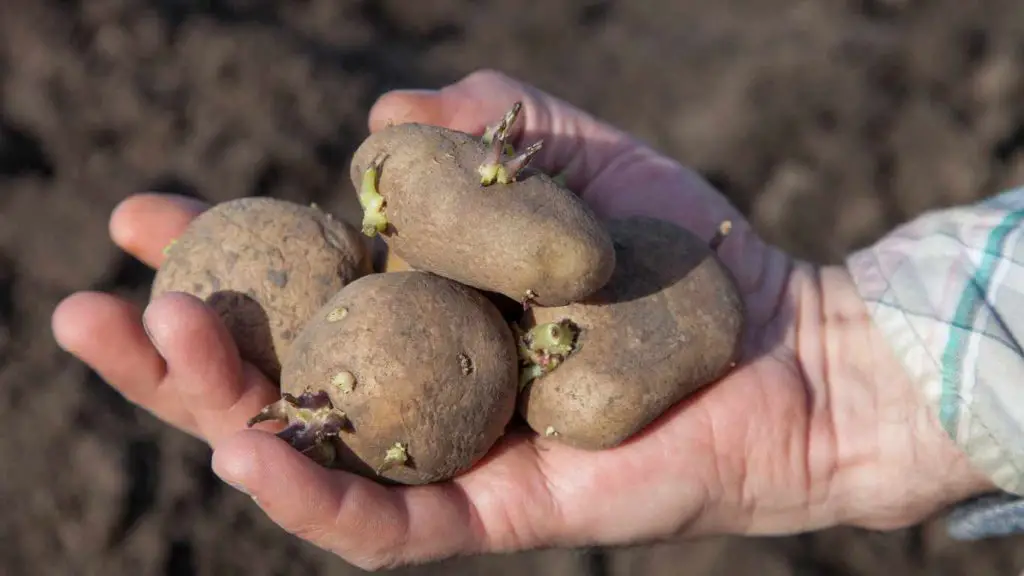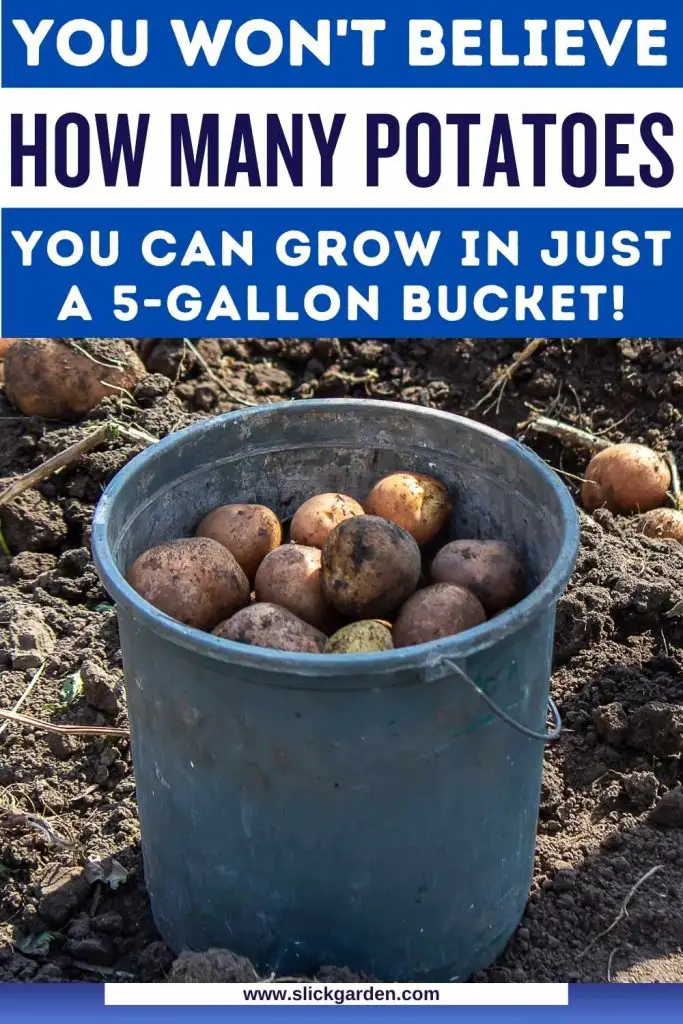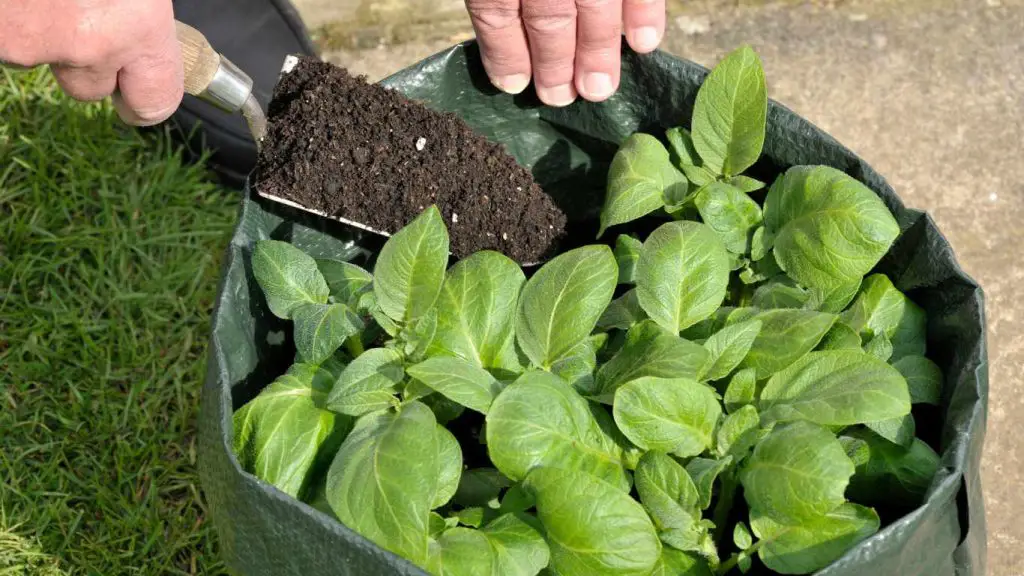Potatoes grow easily in small spaces, such as backyards or balconies, because they are a versatile and nutritious staple in many diets. A 5-gallon bucket works well for growing potatoes in small spaces because it is a small but sturdy container.
Five-gallon buckets are perfect for container gardening in urban or small spaces because they are reasonably priced, practical, and simple to find.
They encourage robust growth and larger yields by giving potato roots plenty of room to spread out. Handles and drainage holes are two more ways to personalize these adaptable buckets.
If gardeners know why it’s better to plant potatoes in containers and use a five-gallon bucket, they can grow healthy and abundant potato crops.
Choose The Right Bucket And Make Holes For Drainage

The following procedures can be used to get a five-gallon bucket ready for potato planting: Drill drainage holes to avoid waterlogging, use a clean, food-grade bucket to stop toxic chemicals from leaking into the soil, and make sure your container garden has enough drainage.
In the absence of drainage holes, extra water may collect at the bottom and cause stagnant conditions that are harmful to the health of the plants. You’re fostering a healthy environment for your potato plants to flourish and yield a bumper crop if you follow these guidelines.
Gravel Or Small Rocks For Drainage
When planting potatoes, the drainage holes in a five-gallon bucket usually work well enough because they let extra water out and keep the soil from becoming soggy and rotting.
For better drainage and soil-hole separation, add gravel or rocks to the bottom of the bucket. This will help to gradually reduce the clogging of soil particles.
Drill drainage holes in a bucket, then cover the area evenly with a layer of gravel or small rocks that is an inch or two thick. After adding soil to plant potatoes as normal, place the gravel or rocks on top.
Select The Right Varieties Of Potatoes
Select cultivars for container gardening that yield well in small areas; popular cultivator types for potatoes grown in five-gallon buckets are among them.
Yukon Gold potatoes are great for container gardening because of their flavor and golden-yellow flesh. Red Norland potatoes mature quickly and have thin red skins with white flesh.
Russet potatoes are great for baking and frying since they are high in starch. Kennebec potatoes are excellent for boiling, baking, or frying because of their smooth skin and white flesh.
All blue potatoes are good for container gardening because of their eye-catching blue/purple flesh and nutritional value. Any of these potatoes can give your garden a vibrant new look.
Enjoy your gardening endeavors by selecting potatoes that suit your preferences and the growing environment. Make sure the bucket has enough room for growth and adequate drainage.
Prepare the Seed Potatoes

Cut healthy seed potatoes into 1- to 2-inch-long pieces that are free of rot or disease. There should be one or two sprouts, also called eyes, on each piece. These are tiny indentations on the potato’s surface that allow new growth to appear.
To ensure successful sprouting and plant development, make sure every piece of seed potato has one or two eyes. Dormant buds found in the eyes grow into stems and leaves when planted. The likelihood of a successful plant growth is increased if every piece has one or two eyes.
It’s important to let seed potatoes cure after cutting them. In order to stop moisture loss, lower the chance of rot and disease, and cure the cut surfaces, a protective layer must be formed and dried.
Allow the cut surfaces to callus over and create a protective barrier by keeping the pieces at room temperature in a well-ventilated area for a few days.
Planting
In order to plant seed potatoes, fill the bucket with soil to the bottom, giving the potatoes a base and guaranteeing stability and nutrition. The depth, usually two to three inches, should be adequate to sustain root growth.
Once the soil has been laid, evenly distribute the seed potato pieces over the surface. Make sure every piece has a minimum of one upward-facing sprouting eye or bud, which permits every plant to get enough nutrients, water, and sunlight without crowding out nearby plants.
After putting the first few inches of soil on top of the seed potato pieces, add a few more inches to ensure that there is enough soil for protection, root development, and moisture retention.
Make sure all of the potato pieces are covered, with the exception of the top foliage that is visible above the soil’s surface.
The actions listed below guarantee that seed potatoes are planted in the best possible conditions, encouraging strong growth and a bountiful crop.
Watering
In a five-gallon bucket, potato cultivation requires regular watering. Here’s how to properly water your potato plants:
Potatoes need constant moisture, especially while they’re developing tubers. Keep a close eye on the soil’s moisture content and modify the frequency of watering according to the climate, growth stage, and weather.
Make sure to water deeply, all the way to the root zone. To prevent diseases, water the area surrounding the base of the plant without getting too wet.

Avoid Waterlogging
Make use of a bucket with drainage holes to avoid waterlogging. To absorb moisture before heat, water in the morning; do not water in the evening to prevent fungal diseases.
Mulch helps to prevent evaporation and retain moisture. Develop a sense of when to water your plants over time by adjusting schedules according to their needs.
Sunlight
Potato plants require sunlight to thrive, even when they are planted in five-gallon buckets.
For potato plants to perform photosynthesis, grow leaves and stems, and develop tubers, they need sunlight. It provides energy for growth and development by converting carbon dioxide and water into glucose.
Sufficient sunshine encourages robust foliage, which enables potatoes to store carbohydrates in their tubers. The sun indicates when resources are required.
For best growth, tuber development, and a successful harvest of homegrown potatoes, place potatoes in a bucket that is well-lit and receives 6 to 8 hours of direct sunlight each day.
Fertilizers

For healthy growth and development, potatoes need a consistent supply of macronutrients like calcium and magnesium as well as essential nutrients like potassium, phosphorus, and nitrogen.
By adding new nutrients to the soil, fertilizer keeps the soil healthy and productive for the duration of the potato growing season. Strong tuber development, especially of potassium, is encouraged by proper fertilization, which results in a crop that is more abundant.
Different stages of potato growth call for different amounts of nutrients; mature plants need more phosphorus and potassium for root development and tuber enlargement, while early stages need more nitrogen for leaf and stem growth.
A balanced supply of nutrients appropriate for each stage of growth is provided by fertilizer. Fertilizing in a five-gallon bucket can help construct resilience in plants, ensuring they can withstand obstacles and yield a healthy crop. Well-fed plants are better able to withstand pests, diseases, and environmental stressors.
Maintenance
A vital step in the growing of potato plants is hilling, which is filling the bucket with more soil. This shields the potatoes from sunlight, which could turn them green and give them a bitter taste, and promotes the growth of more tubers along the buried stems.
Monitor For Pests And Diseases
Keeping an eye out for pests and diseases is essential to keeping potato plants healthy. Common pests include caterpillars, aphids, and potato beetles, while diseases like blight and fungal infections can hinder growth and yield.
Plant protection depends on the ability to recognize pests and diseases. To stop the spread of disease, this may entail hand-picking, applying fungicides or pesticides made of organic materials, or putting cultural customs into place.
In order to address pest and disease issues early and ensure a healthy and productive harvest of delicious potatoes, proactive management and routine inspection are essential.
Harvesting

Potato plants undergo subterranean maturation when they turn yellow and die back. Examine the soil for fully grown potatoes by digging or feeling the surrounding areas.
Although some cultivars bloom prior to fully developing tubers, this is not a consistent marker. It is advised to combine this with other indications.
Make sure the soil is dry before sorting through it to harvest potatoes.
After loosening the soil, pour it into a container. Gather potatoes by hand, being careful not to bruise them. Take out any extra dirt, shake off anything that is clinging to the potatoes, and look for any indications of illness or damage. Throw away any diseased or damaged tubers.
Storing Harvested Potatoes
Harvested potatoes should be cured for one to two weeks in a cool, dry, and well-ventilated area to strengthen their skins and heal small wounds.
Keep in dark, cool, and humid conditions; do not store in plastic bags. Instead, use breathable containers. To stop potatoes from spoiling, regularly check them and remove any spoiled ones.
